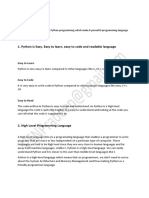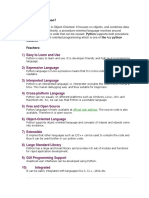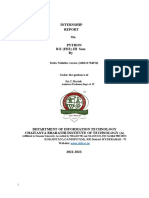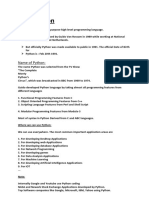0% found this document useful (0 votes)
7 views3 pagesModule 1
The document outlines key features of Python, highlighting its readability, simplicity, and extensive libraries, which contribute to its popularity for various applications. It explains that Python is an interpreted language, detailing the process of code execution. Additionally, it lists the benefits and diverse applications of Python, including web development, data analysis, and machine learning.
Uploaded by
Neelesh KannanCopyright
© © All Rights Reserved
We take content rights seriously. If you suspect this is your content, claim it here.
Available Formats
Download as DOCX, PDF, TXT or read online on Scribd
0% found this document useful (0 votes)
7 views3 pagesModule 1
The document outlines key features of Python, highlighting its readability, simplicity, and extensive libraries, which contribute to its popularity for various applications. It explains that Python is an interpreted language, detailing the process of code execution. Additionally, it lists the benefits and diverse applications of Python, including web development, data analysis, and machine learning.
Uploaded by
Neelesh KannanCopyright
© © All Rights Reserved
We take content rights seriously. If you suspect this is your content, claim it here.
Available Formats
Download as DOCX, PDF, TXT or read online on Scribd
/ 3

























































